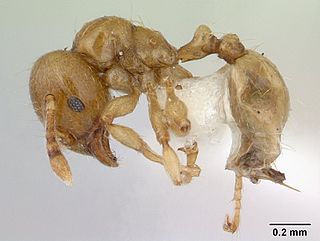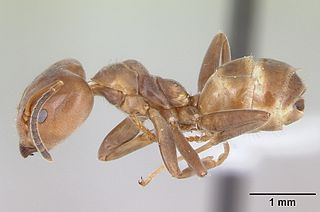
Allomerus decemarticulatus is an Amazonian ant species found in the tropics of South America. This species is most notable for the workers’ complex and extreme predatory behavior, which involves a symbiosis with both a plant and fungal species. They live in leaf pockets of a host plant species, Hirtella physophora. These leaf pockets are areas inside of the plant between the leaves and the stem. Each colony, which consists of about 1,200 workers, inhabits a single tree; however, the ants are spread among the leaf pockets, with typically 40 workers per pocket. Their diet primarily consists of large insects that are captured on the plant, but they also eat some kinds of food bodies produced by the plant as well as its nectar. They are able to capture their prey, which is much larger than themselves, by constructing a platform that acts as a trap for the unsuspecting prey. The ants hide in the trap and attack when any insect lands on it. This technique is an example of ambush predation.

Trophobiosis is a symbiotic association between organisms where food is obtained or provided. The provider of food in the association is referred to as a trophobiont. The name is derived from the Ancient Greek τροφή (trophē), meaning "nourishment", and -βίωσις (-biosis), which is short for the English word symbiosis.

Acropyga is a genus of small formicine ants. Some species can be indirect pests. A. acutiventris, which is found from India to Australia, tends subterranean, root-feeding mealybugs of the species Xenococcus annandalei. Living, gravid females are carried in the jaws of A. acutiventris queens during their nuptial flight, to establish the symbiotic association in founding colonies. Other Acropyga species have relationships with different species of mealybugs, and it could be a trait common to the whole genus.

Gracilidris is a genus of dolichoderine ants with nocturnal behaviour; thought to have gone extinct 15-20 million years ago, they have been found in Paraguay, Brazil, and Argentina and were described in 2006.
Nothomicrodon aztecarum is a species of Neotropical flies, originally described from a larva collected in 1924 from a carton nest of the ant Azteca trigona. It is the only species in the genus Nothomicrodon, but shows none of the features of a hoverfly larva, the family in which it was originally classified, and instead belongs in the family Phoridae.
Azteca andreae is an arboreal ant species found in the tropics of South America, most notably in French Guiana. They are most notable for their predatory skills and strength. They are ambush predators that are able to capture and eat other insects much greater than their own size.

Azteca is a strictly Neotropical genus of ants in the subfamily Dolichoderinae. The genus is very diverse and contains around 84 extant species and two fossil species. They are essentially arboreal and many species have mutualistic associations with particular plant species, where the genus Cecropia presents the most conspicuous association. In the Brazilian Amazonia, Azteca species are associated with species of Codonanthopsis.

Typhlomyrmex is a genus of ants in the subfamily Ectatomminae and the sole member of the tribe Typhlomyrmecini. Known from the Neotropics, the genus has a wide distribution. Some species are restricted in range, while for example Typhlomyrmex rogenhoferi is known from southern Mexico to northern Argentina. Little is known about their biology. The genus 'Typhlomyrmex' means 'blind ant'. All species of this genus contains only blind ants.

Leptanilloides is a genus of ants in the subfamily Dorylinae. Leptanilloides is an uncommonly collected genus with subterranean habits in the New World Andean and sub-Andean tropics.

Sphinctomyrmex is a genus of ants in the subfamily Dorylinae. The genus is a tropical and distinctive group, originally described by Mayr based on a single gyne collected in Brazil. Morphologically, the genus is characterized by the unique arrangement of the gastric segments, which are nearly equal in length and separated from each other by distinct constrictions. Very little is known on the natural history of Sphinctomyrmex. The few observations so far suggest that ants of this genus are nomadic predators of other ants. The genus Zasphinctus and approximately 20 species were formerly included, but were split out during revision of the Dorylinae genera by Borowiec (2016).

Daceton is a Neotropical genus of ants in the subfamily Myrmicinae. The genus contains only two species: D. armigerum, the most studied species, distributed throughout northern South America, and D. boltoni, known from Brazil and Peru.

Melissotarsus is a rare African genus of ants in the subfamily Myrmicinae. They are known from the Afrotropics and Malagasy regions, where their nests are located in living wood, built by tunneling through the wood under the bark. They are rarely seen outside of their nests, which may contribute to their perceived rarity. However, they are considered pest insects because of damage they can cause to trees, including economically important ones such as mangos and trees in the family Burseraceae, including Aucoumea klaineana, Dacryodes buettneri, and Dacryodes edulis.

Gigantiops is a South American genus of jumping ants in the subfamily Formicinae. The genus contains the single species Gigantiops destructor, which is also the sole member of the tribe Gigantiopini. They have the largest eyes among all ants, are known for their ability to jump, and have the highest number of chromosomes of any member of the subfamily Formicinae (2n=78).

Daceton armigerum is a Neotropical species of arboreal ants, distributed throughout northern South America. D. armigerum combines several traits generally noted in some other arboreal ants i.e., populous colonies, large and/or polydomous nests, intra- and interspecific aggressiveness, trophobiosis, and capturing prey by spread-eagling them.
Sphinctomyrmex marcoyi is a Neotropical species of ants in the subfamily Dorylinae. It is the only Sphinctomyrmex species recorded in the Amazon Forest. Gynes and males are unknown.
Sphinctomyrmex schoerederi is a Neotropical species of ants in the subfamily Dorylinae. S. schoerederi is known only from the holotype, collected in a leaf litter sample from a forest remnant in the campus of Universidade Federal de Viçosa in Brazil, where it occurs in sympatry with S. stali. Gynes and males are unknown.
Fulakora is a genus of ants in the subfamily Amblyoponinae. The genus has a worldwide distribution, and like most other amblyoponines, Fulakora species are specialized predators. It was originally described as, and for a long time considered to be, a subgenus of Stigmatomma until it was elevated to an independent genus by Ward & Fisher (2016).

Azteca alpha is an extinct species of ant in the subfamily Dolichoderinae known from possibly Miocene fossils found on Hispaniola. A. alpha is one of only two species in the genus Azteca to have been described from fossils, both found in Dominican amber. It is the host for a fossil nematode, and has been preserved with scale insects.

Azteca alfari is a species of ant in the genus Azteca. Described by Carlo Emery in 1893, the species is widespread in Mexico, Central and South America. This ant has a mutualistic relationship with a Cecropia tree. The specific name alfari honours a Costa Rican zoologist Anastasio Alfaro.

Passiflora glandulosa, more commonly known as wild passion fruit, is a short deciduous climbing plant with stems that can grow up to 20 m (66 ft) long. The genus Passiflora is known for its colorful flowers, which is also prominent in the glandulosa species. Named by Antonio José Cavanilles in 1790, Passiflora glandulosa is native to many regions of the northeast coast of South America, having a neotropic distribution. In specific, Passiflora glandulosa is heavily populated in Guyana, Suriname, Brazil and French Guiana.












